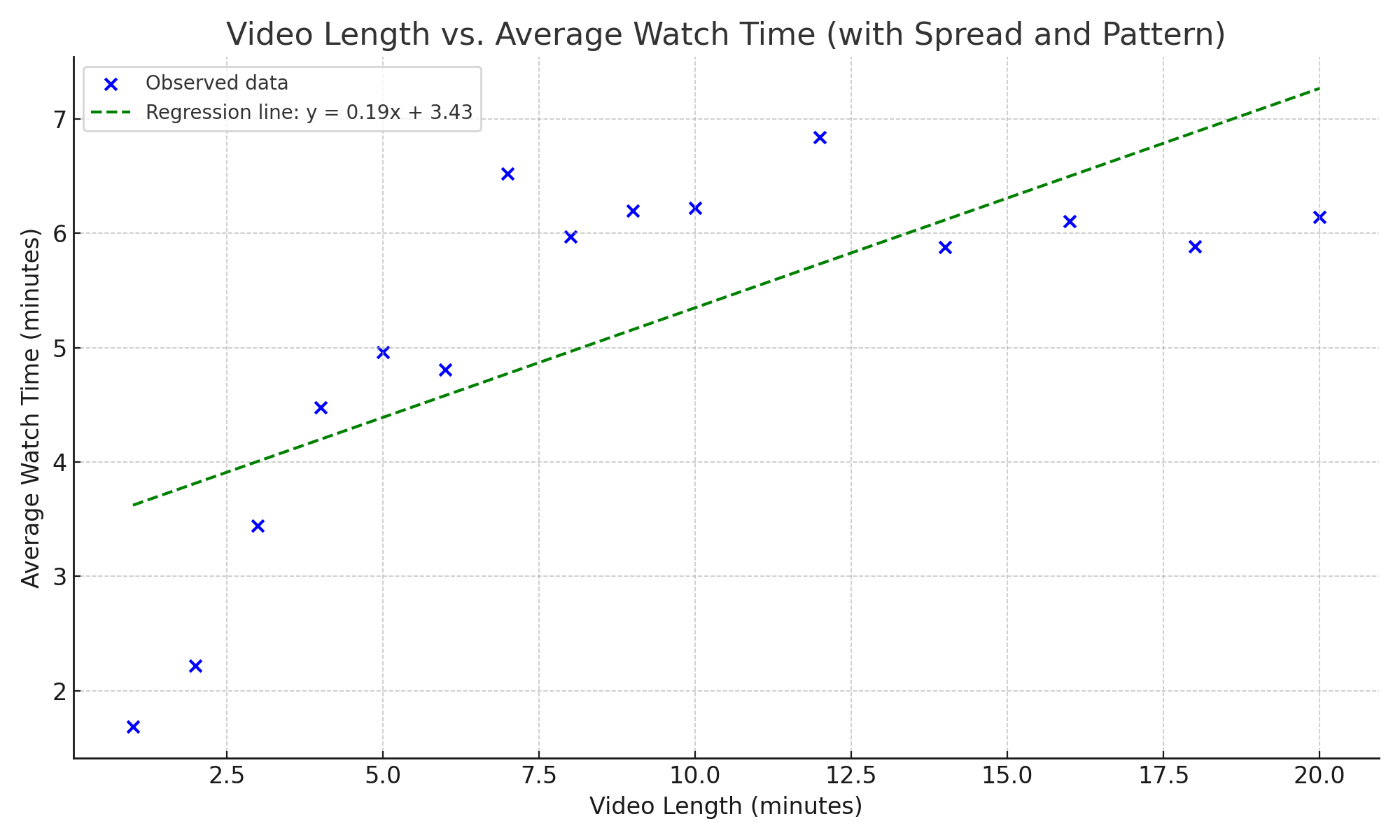Tag: SPSS
-

What has Linear Regression ever done for you?
Understanding Linear Regression in Media Studies This webpage offers a clear and practical introduction to linear regression tailored for students in media studies. It explains core concepts like the regression equation, slope, and intercept, and connects them directly to real-world media scenarios—such as predicting viewer engagement based on video length. The resource includes: Step-by-step guidance…
-
Confidence Interval
As a teacher, I often find that confidence intervals can be a tricky concept for students to grasp. However, they’re an essential tool in statistics that helps us make sense of data and draw meaningful conclusions. In this blog post, I’ll break down the concept of confidence intervals and explain why they’re so important in…
-
Regression
Statistical regression is a powerful analytical tool widely used in the media industry to understand relationships between variables and make predictions. This essay will explore the concept of regression analysis and its applications in media, providing relevant examples from the industry. Understanding Regression Analysis Regression analysis is a statistical method used to estimate relationships between…
-
Overview Formulas Statistics
Mean Median Range Variance Standard Deviation Correlation Pearson’s r Correlation Spearman’s rho t-test (Independent and Dependent) Chi-Square Test These statistical tools are fundamental for analyzing data sets, allowing researchers to summarize data, assess relationships, and test hypotheses. Citations:[1] https://www.geeksforgeeks.org/mathematics-mean-variance-and-standard-deviation/[2] https://www.sciencing.com/median-mode-range-standard-deviation-4599485/[3] https://www.csueastbay.edu/scaa/files/docs/student-handouts/marija-stanojcic-mean-median-mode-variance-standard-deviation.pdf[4] https://www.youtube.com/watch?v=179ce7ZzFA8[5] https://www.youtube.com/watch?v=mk8tOD0t8M0[6] https://eng.libretexts.org/Bookshelves/Industrial_and_Systems_Engineering/Chemical_Process_Dynamics_and_Controls_(Woolf)/13:_Statistics_and_Probability_Background/13.01:_Basic_statistics-_mean_median_average_standard_deviation_z-scores_and_p-value[7] https://www.ituc-africa.org/IMG/pdf/ITUC-Af_P4_Wks_Nbo_April_2010_Doc_8.pdf[8] https://www.calculator.net/mean-median-mode-range-calculator.html
-
Standard Deviation
Standard deviation is a statistical measure that quantifies the amount of variation or dispersion in a set of values. In simpler terms, it indicates how much individual data points in a dataset deviate from the mean (average) value. A low standard deviation means that the data points tend to be close to the mean, whereas…
-
Mode
The mode is a statistical measure that represents the most frequently occurring value in a data set. Unlike the mean or median, which require numerical calculations, the mode can be identified simply by observing which number appears most often. This makes it particularly useful for categorical data where numerical averaging is not possible. For example,…
-
Convenience Sampling
Convenience sampling is a non-probability sampling technique where participants are selected based on their ease of access and availability to the researcher, rather than being representative of the entire population (Scribbr, 2023; Simply Psychology, 2023). This method is often used in preliminary research or when resources are limited, as it allows for quick and inexpensive…
-
Chi Square test
The Chi-Square test is a statistical method used to determine if there is a significant association between categorical variables or if a categorical variable follows a hypothesized distribution. There are two main types of Chi-Square tests: the Chi-Square Test of Independence and the Chi-Square Goodness of Fit Test. The Chi-Square Test of Independence assesses whether…
-
Correlation (Scale Variables)
Correlation for scale variables is often assessed using the Pearson correlation coefficient, denoted as $$ r $$, which measures the linear relationship between two continuous variables (Statology, n.d.; Scribbr, n.d.). The value of $$ r $$ ranges from -1 to 1, where -1 indicates a perfect negative linear correlation, 0 indicates no linear correlation, and…
-
Correlation Ordinal Variables
Correlation for ordinal variables is typically assessed using Spearman’s rank correlation coefficient, which is a non-parametric measure suitable for ordinal data that does not assume a normal distribution (Scribbr, n.d.). Unlike Pearson’s correlation, which requires interval or ratio data and assumes linear relationships, Spearman’s correlation can handle non-linear monotonic relationships and is robust to outliers.…
-
Reporting Significance levels (Chapter 17)
Introduction In the field of media studies, understanding and reporting statistical significance is crucial for interpreting research findings accurately. Chapter 17 of “Introduction to Statistics in Psychology” by Howitt and Cramer provides valuable insights into the concise reporting of significance levels, a skill essential for media students (Howitt & Cramer, 2020). This essay will delve…
-
Probability (Chapter 16)
Chapter 16 of “Introduction to Statistics in Psychology” by Howitt and Cramer provides a foundational understanding of probability, which is crucial for statistical analysis in media research. For media students, grasping these concepts is essential for interpreting research findings and making informed decisions. This essay will delve into the relevance of probability in media research,…
-
Chi Square test (Chapter 15)
The Chi-Square test, as introduced in Chapter 15 of “Introduction to Statistics in Psychology” by Howitt and Cramer, is a statistical method used to analyze frequency data. This guide will explore its core concepts and practical applications in media research, particularly for first-year media students. Understanding Frequency Data and the Chi-Square Test The Chi-Square test…
-
Unrelated t-test (Chapter14)
Unrelated T-Test: A Media Student’s Guide Chapter 14 of “Introduction to Statistics in Psychology” by Howitt and Cramer (2020) provides an insightful exploration of the unrelated t-test, a statistical tool that is particularly useful for media students analyzing research data. This discussion will delve into the key concepts, applications, and considerations of the unrelated t-test…
-
Related t-test (Chapter13)
Introduction The related t-test, also known as the paired or dependent samples t-test, is a statistical method extensively discussed in Chapter 13 of “Introduction to Statistics in Psychology” by Howitt and Cramer. This test is particularly relevant for media students as it provides a robust framework for analyzing data collected from repeated measures or matched…
-
Correlation (Chapter 8)
Understanding Correlation in Media Research: A Look at Chapter 8 Correlation analysis is a fundamental statistical tool in media research, allowing researchers to explore relationships between variables and draw meaningful insights. Chapter 8 of “Introduction to Statistics in Psychology” by Howitt and Cramer (2020) provides valuable information on correlation, which can be applied to media…
-
Relationships Between more than one variable (Chapter 7)
Exploring Relationships Between Multiple Variables: A Guide for Media Students In the dynamic world of media studies, understanding the relationships between multiple variables is crucial for analyzing audience behavior, content effectiveness, and media trends. This essay will explore various methods for visualizing and analyzing these relationships, adapting concepts from statistical analysis to the media context.…
-
Standard Deviation (Chapter 6)
The standard deviation is a fundamental statistical concept that quantifies the spread of data points around the mean. It provides crucial insights into data variability and is essential for various statistical analyses. Calculation and Interpretation The standard deviation is calculated as the square root of the variance, which represents the average squared deviation from the…
-
Guide SPSS How to: Calculate the Standard Error
Here’s a guide on how to calculate the standard error in SPSS: Method 1: Using Descriptive Statistics Method 2: Using Frequencies Method 3: Using Compare Means Tips: Remember, the standard error is an estimate of how much the sample mean is likely to differ from the true population mean[6]. It’s a useful measure for assessing…
-
Standard Error (Chapter 12)
Understanding Standard Error for Media Students Standard error is a crucial statistical concept that media students should grasp, especially when interpreting research findings or conducting their own studies. This essay will explain standard error and its relevance to media research, drawing from various sources and adapting the information for media students. What is Standard Error?…
-
Guide SPSS How to: Calculate ANOVA
Here’s a step-by-step guide for 1st year students on how to calculate ANOVA in SPSS: Step 1: Prepare Your Data Step 2: Run the ANOVA Step 3: Additional Options Step 4: Post Hoc Tests Step 5: Run the Analysis Click “OK” in the main One-Way ANOVA dialog box to run the analysis Step 6: Interpret…
-
Guide SPSS How to: Calculate the dependent t-test
Here’s a guide for 1st year students on how to calculate the dependent t-test in SPSS: Step-by-Step Guide for Dependent t-test in SPSS 1. Prepare Your Data 2. Open SPSS and Enter Data 3. Run the Test 4. Interpret the Results 5. Report the Results Tips: Remember, practice with sample datasets will help you become…
-
Guide SPSS How to: Calculate the independent t-test
Step-by-Step Guide Interpreting the Results Tips
-
Guide SPSS How to: Calculate Chi Square
Interpreting the Results Main Weakness of Chi-square Test The main weakness of the Chi-square test is its sensitivity to sample size[3]. Specifically: To address this weakness, always check the “Expected Count” in your output to ensure the assumption is met. If not, consider combining categories or using alternative tests for small samples, such as Fisher’s…
-
Guide SPSS How to: Correlation
Calculating Correlation in SPSS Step 1: Prepare Your Data Step 2: Access the Correlation Analysis Tool Step 3: Select Variables Step 4: Choose Correlation Coefficient Step 5: Additional Options Step 6: Run the Analysis Interpreting the Results Correlation Coefficient Statistical Significance Sample Size Remember, correlation does not imply causation. Always interpret your results in the…
-
Guide SPSS how to: Measures of Central Tendency and Measures of Dispersion
Here’s a guide for 1st year students to calculate measures of central tendency and dispersion in SPSS: Calculating Measures of Central Tendency Calculating Measures of Dispersion Interpreting the Results Choosing the Appropriate Measure Remember, if your distribution is skewed, the median may be more appropriate than the mean for interval/ratio data.
